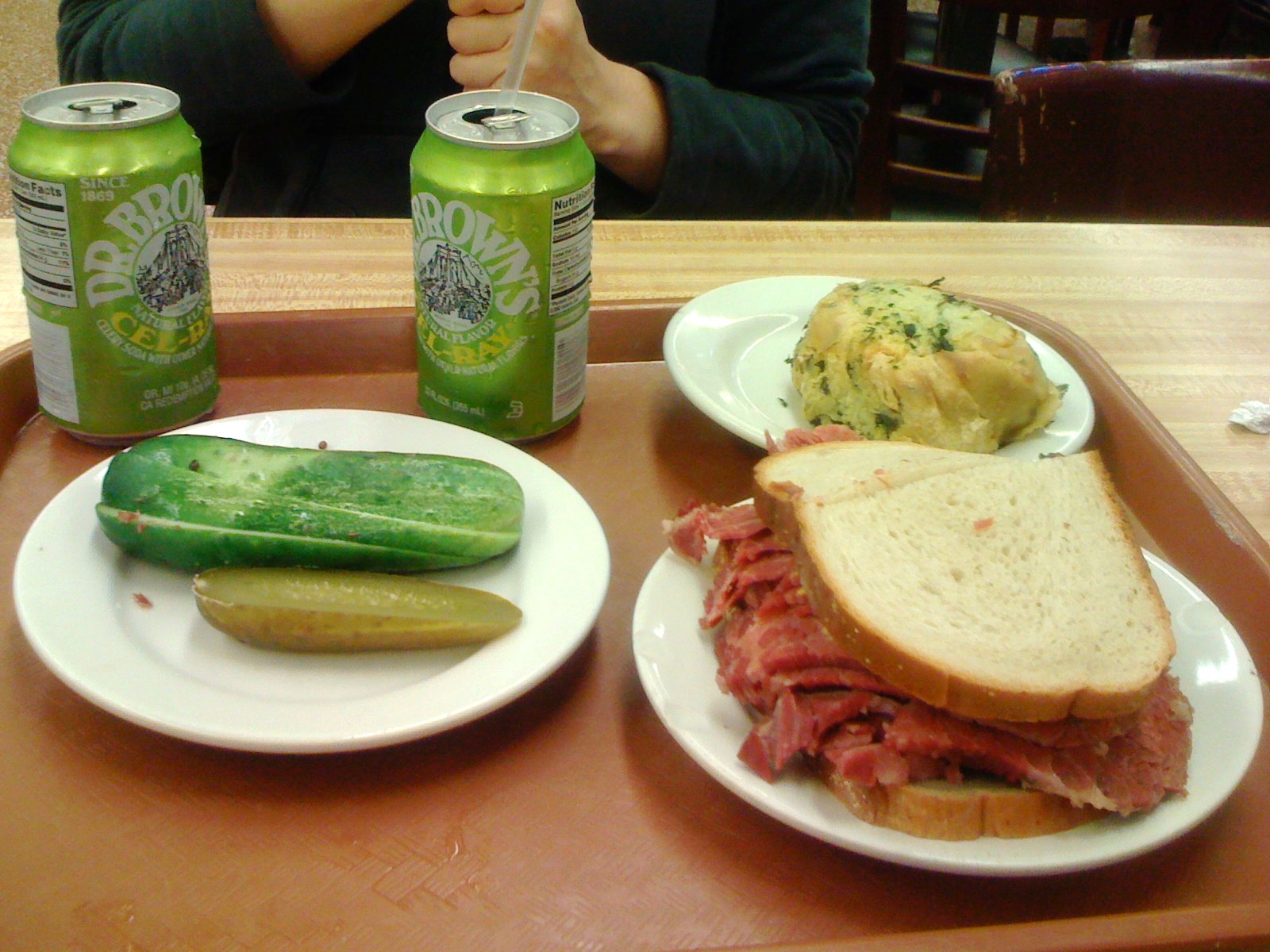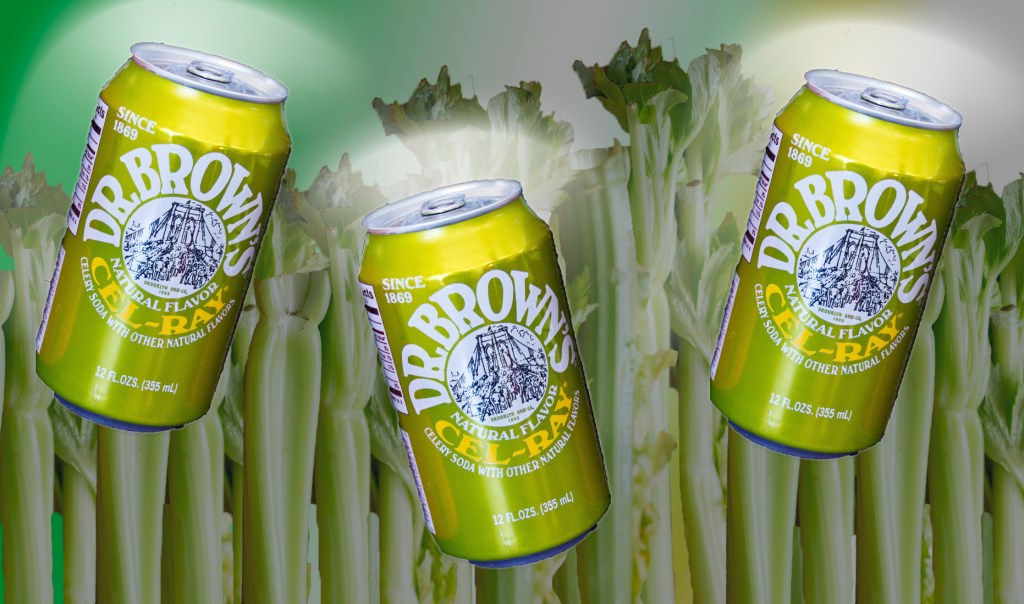Welcome to #NotAnAd, where we post enthusiastically and without reservation about things we’re obsessed with from the world of food.
Almost everything I was told about the realities of living in New York City has turned out to be true: I’ve been attacked by a horde of mutant trash rats, eaten a metric ton of perfect pizza, and instinctually yelled, “I’m walkin’ here!” at several vehicles that have attempted to flatten me in crosswalks.
Videos by VICE
But four years in, I’m feeling let down about one thing: Why is it still so hard to find a celery soda?
The proliferation of Jewish delis throughout all five boroughs had felt like a guarantee. Sure, there are a few. Fine—a bunch. But they aren’t everywhere, certainly not in north Brooklyn, and worse yet, not all of them have the greatest carbonated beverage in the world: Dr. Brown’s Cel-Ray soda.
For those of you who have never had the fortune of sipping from one of those virescent cans: Yes, this is a celery-flavored soda. But don’t be alarmed.
I don’t remember the first time that I tasted a Cel-Ray, but it was surely at the recommendation of my father. He has always taken a strange pride in eating foods that sound highly suspect, like jarred sweet banana wax peppers (which are actually great), Taco Bell’s little-ordered side dish of “pintos and cheese” (also great), Entenmann’s eternally shelf-stable Raspberry Danish Twist (phenomenal), and pretty much anything that makes gentiles shudder (i.e., gefilte fish, which I find not so great).
It is in this familial tradition that I, even as a young child, possessed the confidence to try this soda that is flavored like a ubiquitous-but-rarely-desired vegetable. Drinking Dr. Brown’s Cel-Ray is just one of those things that Jews are wont to do (its long-running nickname is “Jewish Champagne”), and as a half-Jew, it soon felt natural.
I have never felt so Jewish than when recently trying to explain my love for this stuff to a table of non-Jews at Katz’s Deli. My Jewish half has no religious roots whatsoever, and is perhaps only evidenced through my prominent nasal hump, occasional usage of the word “schmuck,” and affinity for delicatessen fare. I had no bat mitzvah and have never been to temple in my life, but spent many Saturdays in my childhood and teenage years eating corned beef sandwiches and drinking Dr. Brown’s in large leather booths, where my father spread out entire newspapers to cover every available inch of the table and pushed the plate of cheese blintzes toward me if he felt that I was somehow still underfed. If he overhears me describing myself as non-denominational, he quickly interjects to say, “You are culturally Jewish.” And while thinking about my lifelong love of celery soda, how can I disagree?
Dr. Brown’s has been in production since 1869—1869!—but even with its lengthy history, it isn’t exactly mainstream. For more than a century, Dr. Brown’s was only sold in New York delis or door-to-door in Jewish neighborhoods, with its Cel-Ray soda marketed as “a pure beverage for the nerves.” Ah, yes—those nerves. Give me your purest anti-”nerves” beverage, now and always.

And who is Dr. Brown, you might ask? Uh, no one is really sure. In a 1986 interview, the company’s director of marketing, Harry Gold, shrugged, “For generation to generation, we’ve been told there was a doctor by that name who invented cream soda and celery tonic now known as Cel-Ray, so far as we know the only vegetable-based carbonated soft drink commercially sold… but we have no records that tell us anything about the good doctor. It’s like a biblical story. We accept it on faith.”
The soda remains contentious even among the Chosen People, however. At the peak of the Flint water crisis a couple of years ago, it was Dr. Brown’s that delis sent in care packages for the city’s elderly Jewish population to provide comfort and familiarity. But the New York Times has called it “a divisive drink, with ardent fans and staunch detractors.” The acclaimed food writer Josh Ozersky (RIP) once said some incredibly unbecoming things about it; specifically, that “Cel-Ray is a nasty, bilious tonic forced upon this generation by the Jewish martyr complexes of the prior one. They grew up eating the bitter herbs that reminded them of slavery and they thought that people should eat bad things as a penance for our crimes.”
So perhaps it is not by Ashkenazi genes alone that Cel-Ray has found its way into my heart. But love it or hate it, I’d like to argue that for complementing and cutting through that salty gristle of a proper piled-high Jewish deli sandwich, nothing else quite compares. There is something poetic about how its flavor is that of crushed celery seeds, which have been used in Eastern medicine for millennia and also sound like they’d make an appearance in a potion in A Midsummer Night’s Dream.
And it tastes great. Well, I think so, anyway. Cel-Ray is sweet, but not too sweet, and only mildly vegetal—not unlike a ginger ale. It is so crisp and so fizzy, offering the same tart, slightly herbaceous, palate-cleansing quality of a gin and tonic. (I’m sure it would make a great mixer, too.)
During that recent episode at Katz’s, I asked one of my dining companions to grab me a can of Cel-Ray from the beverage counter. He returned empty-handed and perplexed, too sheepish to ask the no-nonsense employees for this old-timey-sounding drink of which he had never heard. He didn’t think they had any, anyway, he told me.
For a moment, my heart sunk. If you can’t get a Cel-Ray soda at Katz’s Deli, is all lost?
But when I approached myself, the Katz’s man put up one finger to say “just a moment,” and when he whirled back around, his outstretched arm held that familiar chartreuse can.
Soda consumption is on the decline these days, unless you’re talking faux-fancy seltzers. Ironically, in a 1991 Times article about the decline in seltzer’s popularity—”Where Seltzer Once Thrived, a Few True Fizzes Remain,” Gold is quoted as saying, “We are no threat to Pepsi, but people who grew up in New York never lose a taste for Cel-Ray.”
I didn’t grow up in New York; I was raised in Northern California, where Jewish delis are few and far between. But there was the one in Burlingame, often empty, where my father and I would idle away a number of those Saturdays. We drank Cel-Ray, of course, and it was almost like we were on the Lower East Side. Crack a can of Cel-Ray, and like magic, a Jewish deli appears around you.
So that’s why I love this celery-flavored soda. It’s perfect for washing down Taco Bell’s pintos and cheese, I swear—and those, at least, you can get almost anywhere.




